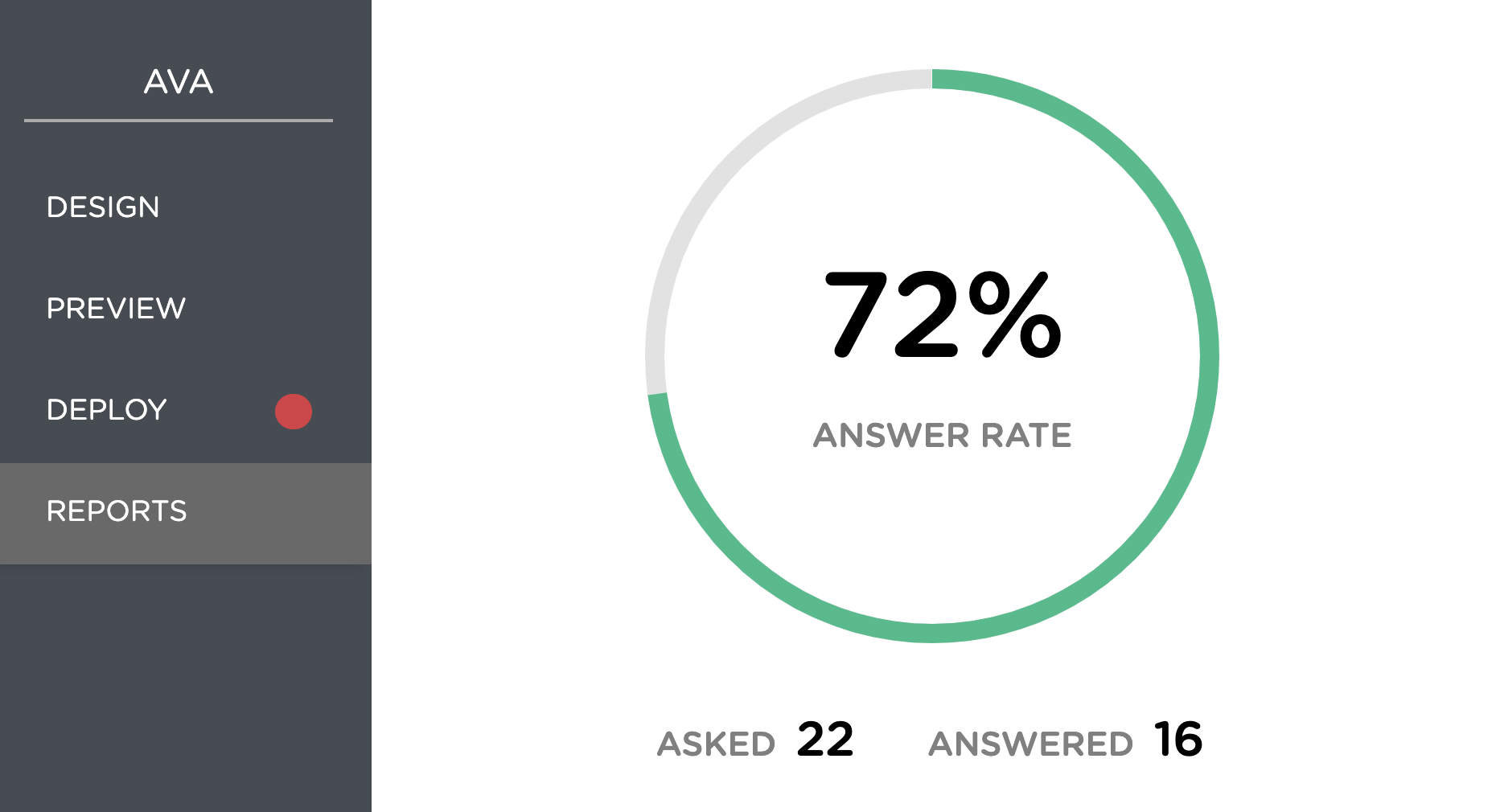Since one of the most popular chatbot uses is to automate customer service, a chatbot's abilities to answer user questions is directly related to brand image and customer satisfaction. Previously, I talked about how to create a Q&A chatbot in a few minutes to answer users' free-text questions and handle complex, multi-turn Q&As, all without coding. Because no chatbot is perfect, I also mentioned how to teach a chatbot handle unknown user questions and further improve customer satisfaction.
But how do we know the performance of a Q&A chatbot? For example, we want to know the "goodness" of a chatbot by asking:
- What are the questions the chatbot has answered? How many of them?
- What are the questions the chatbot cannot answer? How many of them?
- Among the unanswered questions, how frequently do users ask these questions?
- How are these unanswered questions related to each other?
Obviously, answers to the above questions can provide chatbot owners or admins valuable insights to improve a chatbot, e.g., improving a chatbot to address the most frequently asked, unanswered questions. Unfortunately, few chatbot platforms provide such insights, which makes a chatbot owner/admin unaware of a Q&A chatbot's performance, let alone helps improving its Q&A capabilities.
To help chatbot owners improve a Q&A chatbot easily and quickly, the Juji platform provides built-in Q&A monitoring facility to inform chatbot owners of their chatbot Q&A performance in real time.
Monitor Overall Chatbot FAQ Performance

Besides monitoring unanswered questions, one can also monitor a chatbot's overall FAQ performance on the Reports page.
As shown above, it lists the number of questions users asked, and the number of questions answered by the chatbot. It also calculates the answering rate. This metric informs a chatbot owner or admin how well a chatbot has performed in answering questions. A low answering rate may be a strong indicator that a chatbot's FAQ abilities need to be updated by checking the Q&A dashboard and addressing the unanswered questions as much as possible.
Using the data, we can also calculate the average number of questions asked per user by the following:
AVG NUM QUESTIONS PER USER = NUM of QUESTIONS/NUM of USERS
Monitor Q&A Chatbot Performance: Monitoring Unanswered User Questions
Additionally, we have built several Q&A chatbot monitoring tools to answer questions 2–4 listed above. Here I focus on how Juji helps chatbot owners obtain answers to these questions and how such insights can help improve a chatbot's Q&A capability quickly.
Ideally, your FAQ list should be as complete as possible. However, it is difficult to anticipate all the questions users might ask. Thus, it is useful to know what user questions are not answered by a chatbot. Juji's Q&A Board does just that. As shown below, the Q&A board provides you with real-time notifications of unanswered user questions as users are interacting with your chatbot.

As shown in the screenshot above, the number shown in red next to the label "Q&A BOARD" indicates the number of unanswered user questions the chatbot has encountered. The number gets updated in real-time. So a chatbot owner can easily know how many unanswered questions are there. In the example above, there are 5 unanswered user questions. Moreover, all the unanswered questions are listed inside a Q&A table where a chatbot owner or admin can answer them right away.
Alternatively, you can download all Q&As including the unanswered questions in a CSV file. The CSV file typically lists all the unanswered user questions and their stats at the end. Juji also automatically analyzes all unanswered questions and arranges them in different groups by their semantic similarity.
As shown in a sample CSV file below, there are five unanswered questions (rows 38-44), arranged into three groups: rows 38-39, rows 41-42, and row 44. Next to each unanswered question, there is also a number indicating how many times (frequency) that question was asked. In the example below, the question "How do I log in" (row 38) was asked once, while another similar question "How do I sign in" was asked twice (row 39).
Such information can then be used to easily prioritize the handling of unanswered questions especially if there are a number of unanswered questions.

Update Chatbot FAQs
To address unanswered user questions, there are two ways to improve a chatbot by updating its FAQ knowledge base. You can update them directly on the Q&A Board. Alternatively, you can update the CSV file, then upload it to the chatbot.
Update FAQs on the Q&A Board
If there are just a few unanswered questions, the quickest way is to add the corresponding answers directly on the Q&A board. To do so, just add an answer in the corresponding text box (labeled as "Chatbot Responses") and submit it using the "Submit" button.
Unless this is a multi-turn answer, the submission will take effect immediately. This is very handy, because it improves a chatbot Q&As immediately without the need to restart it.
Answer an unanswered user question
Assume that an unanswered user question pops up on the Q&A Board. As a chatbot owner, you can answer it and submit the answer right away. ALL the users including the one who asked the question originally can now ask the question and get a correct answer without restarting their chat. This nondisruptive nature of the updates has proven to be very valuable to many of our clients that have a large number of users.

As shown above in a screenshot, the Q&A Board also provides several useful tools to help a chatbot owner customize answers:
- The "+" sign in a text box (either the "User Questions" or "Chatbot Responses" column) allows you to enter alternative question/answer expressions, while the downward arrow button allows you to view and select these varied expressions. Question variations help a chatbot better recognize user questions. On the other hand, answer variations give a chatbot a set of answers to choose from, so its response can appear more natural to users.
- The "→A" button on the top right corner of the "Chatbot Responses" text box lets you search for an answer of a matched question, saving your time to enter an answer from scratch. This is especially helpful if there is an extensive existing Q&A list.
- The "[+]" button on the bottom right of the "Chatbot Responses" text box lets you open up an editor to define or edit a multi-turn answer. My previous blog post explained this powerful tool.
Add a new pair of Q&A
Moreover, the Q&A Board allows you to directly add new Q&A pairs. To add a new pair of Q&A, simply click on the "+" sign at the top of the table. You can then edit the question and its answer as described above.
Update an existing Q&A pair
Similarly, you can select an existing Q&A pair to edit by clicking on the magnifying glass icon next to the "+" sign. As shown below, it will open up a pop-up window where you can search for an existing Q&A. In the pop-up window, you can see all Q&As including their question and answer variations. Once you select a Q&A, it will show up in a row in the Q&A table for you to update.

Update and upload your FAQ CSV file
Although the Q&A Board makes it very easy to update your FAQs, updating the FAQs inside the CSV file may be more convenient if there is a large number of unanswered questions or if there are multiple people involved in updating the FAQs.
You can simply upload your CSV after all the editing is done. In case you are not already familiar with how to update the FAQs in a CSV file, you can check out my previous blog on this.
Answering user questions is an important skill for almost all chatbots. That's why Juji Q&A dashboard exists to help chatbot designers and owners monitor their chatbots in real time and improve their chatbots quickly.
Creating a chatbot and publishing it is not the end but often the beginning of a journey. Just like raising a kid, who needs to be taught and nurtured as s/he grows, a chatbot designer or owner will need to keep a chatbot up to date and constantly teach it new knowledge and skills. Over time, a chatbot can become better and better at its tasks.
If you would like to learn more about what kind of smarts Juji chatbots have, this is a great article to start. Or sign up free to have some fun of creating your own smart chatbots.




